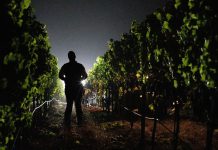
Yard art around town comes in many forms. Whimsical. Creative. Unique. Here are a fun few. These cacti sporting sunglasses and straw hats are out on Dry Creek Road. The water-saving rock spiral lawn with pink flamingos is along University Avenue.
If you look closely, especially when walking, yard art jumps out at you. Noticing hidden art can be like buying a new model car and suddenly seeing it everywhere. Much of the time, it is in plain sight, yet stopping to notice what’s in front of us is overlooked.
Noticing is a skill helped by slower movement, and time to be curious. It seems slowing down was, or is, a silver-lining of the pandemic. Pausing. Being present. Going slower. Sensing with senses.
If you see whimsical yard art, let me know. Send me a picture. I’m collecting pauses, oh and pictures of yard art. Email: pj*****@****ud.com.
Fun facts: Palm trees are found here in Northern California, and all the way up in Washington State on the Alki peninsula. The one pictured here is a Canary Island date palm (Phoenix canariensis). Only one type of palm is native to California, and oddly it’s called Washingtonia filifera. It grows in sandy soils fed by springs east of Los Angeles. Hence, the place name Palm Springs.
There are about 2,500 different species of palm, with about 25 being common plants in the U.S. Palm trees are often associated with Los Angeles’ landscape, possibly because 25,000 trees were planted to line major streets for the 1932 Olympics. Since palm trees last about 100 years, LA’s palms are senescing.
The cacti pictured above, with the hat and sunglasses, is an organ pipe cactus (Stenocereus thurberi). These plants flower at night, with their spectacular blooms withering and dying in the morning. Native to an area in South Texas and Mexico, Sonoma’s hot and mild environment allows them to thrive. The cute little Arizona barrel cactus is Ferocactus wislizeni. There are approximately 2,000 cactus species.








